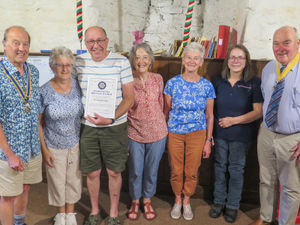Odd items found in Mid Wales Osprey nest
Volunteers have unearthed a variety of odd items after exploring an osprey nest at a nature reserve.
Throughout the summer visitors were transfixed by the lives of Monty and Glesni, a breeding pair of ospreys at the Dyfi Osprey Project near Machynlleth.
The pair produced three chicks, Celyn, Merin and Brenig, and the family migrated to Africa in September.
Staff at the project have taken the opportunity to visit the nest to check its structural integrity and remove any items which could be harmful to the birds.
Project member Emyr Evans said: "Monty and Glesni probably carry more than 100kg of material to the nest every year and this, especially when it's wet, puts a huge load on the nest material beneath it. We usually take away around two feet off the top layer of nesting material each year."
Mr Evans said the team found eight unusual things in the nest, including bones possibly belonging to a goose, thousands of fish scales, and bark, which the ospreys use to keep their beaks and talons in good condition.
They also recovered a length of baler twine, which could be fatal to an osprey if it got caught up in it, and goose feathers which the ospreys had used to line the nest, as well as one osprey feather possibly lost by Brenig after a scuffle with his sister Merin.
There was also a rather smelly gift left for the volunteers.
Mr Evans said: "Along with dung beetles, ospreys have a penchant for cow pats, and we found some in the nest. In conjunction with the mullet scales, Monty and Glesni leave us with an unforgettable smell every winter to remember them by.
"And we found some operculum as well - the bony covering which protects the gills of a fish. These are usually too big to eat and opercula are discarded by ospreys either in the nest or beneath feeding perches. We collect these every year and put them in our operculum box to show visitors and children the following season in the visitor centre."
The work carried out on the nest is essential to ensure that it is ready for the ospreys when they return in the spring.
Mr Evans said: "With winds of up to 100mph recorded on the Dyfi estuary during the winter months in some years, the nest could easily be weakened and become unstable and fall. Worse still, it could be structurally compromised in such a way that we don't notice, only for it to fall or break up in bad weather in April onwards once the ospreys are back; then we would be in all sorts of trouble – and so would Monty and Glesni.
"We service and clean the cameras while we're up there and we have an opportunity to take anything that could be harmful away.
"We want to thank all the volunteers that helped us at the nest site, especially Sarah who climbed the ladder and got her hands dirty - quite literally."





